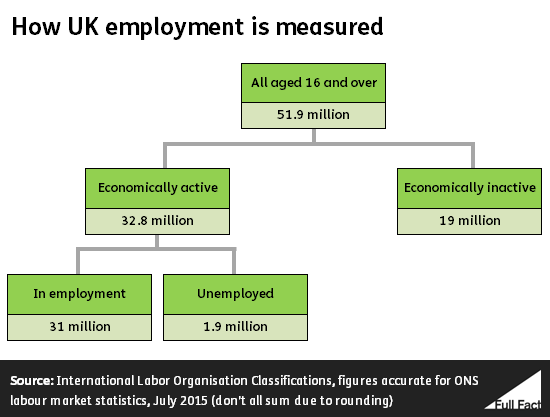Ask Full Fact: Employment, unemployment and jobseekers
This article has been updated.
Over on our Facebook page, some readers had questions about our roundup of employment figures.
Where does the unemployment figure of 1.85 million come from, is it a count or an estimate? If it's an estimate what is the margin of error?
The Labour Force Survey figures are estimates, so there is some uncertainty about their value.
Join 72,953 people who trust us to check the facts
Sign up to get weekly updates on politics, immigration, health and more.
Subscribe to weekly email newsletters from Full Fact for updates on politics, immigration, health and more. Our fact checks are free to read but not to produce, so you will also get occasional emails about fundraising and other ways you can help. You can unsubscribe at any time. For more information about how we use your data see our Privacy Policy.
When we look at unemployment, the headline figure is that there are about 1,853,000 people who are unemployed and looking to start work. That's the best single figure estimate available, and 19 times out of 20, the true figure is going to be between about 1,778,000 and 1,928,000.
How does this relate to the figures for claiming Jobseeker's Allowance and Universal Credit. Are people sanctioned included in the 1.85 million or not?
The number of people who are unemployed isn't the same as the number of people claiming Jobseeker's Allowance. The unemployment measure looks at people who have looked for work in the past 4 weeks, and are ready to start work in the next 2 weeks. People who are still out of work, but are starting a job in the next two weeks are also unemployed.
If you match one of these descriptions, you're counted as unemployed no matter what benefits you do or don't claim.
The claimant count looks at the number of people claiming Jobseeker's Allowance, and people out of work claiming Universal Credit. Not all people claiming this benefit are unemployed—for example, some low paid part-time workers can claim it, and some out of work Universal Credit claimants aren't required to look for work. And not all unemployed people can claim Jobseeker's Allowance.
People who claim these benefits show up in the claimant count if they don't receive payment, so a person who has their benefits sanctioned will still be in the count. If they don't sign on while sanctioned, their claim will be closed and they'll drop out of the count.
There aren't reported confidence intervals for the claimant count because this measure is based on the data the government collects when it makes payments.
Why does the proportion of people aged from 16 to 64 who were employed (73.3%) plus the inactive (22.2%) not come to 100%? What are the missing 4.5% doing?
The employment and inactivity rates don't sum to 100% because some people are unemployed.
Economically active means that you are either employed, or unemployed. Economically inactive means that you aren't in either of those categories. This would include retirees or stay-at-home parents.
The unemployment rate is the proportion of economically active people who are unemployed.
More generally, in the headline indicators, the employment, unemployment and inactivity rates don't sum to 100 because they're percentages of different groups. The employment and inactivity rates are for all people aged between 16 and 64, but the unemployment rate is for economically active people aged 16+.
Did the fall in long term unemployment happen because people found work, or because people were sanctioned?
Long term unemployment fell from 623,000 to about 570,000 in the latest figures. That's people who were unemployed for over a year—the international definition used by the Organisation for Economic Cooperation and Development.
This fall didn't necessarily happen for either reason. A person's status as an unemployed person doesn't depend on what benefits they claim, so if the number of long-term unemployed has fallen, it's because there are fewer people "looking" for work.
That could be because they've found a job, or because they've given up looking. The latest figures show 265,000 more people employed than there were 12 months before.
Benefits sanctions don't directly affect the number of unemployed people; the only way they can have an effect is if they're effective in moving people into work. The Institute for Fiscal Studies say it is "unclear" if the increased use of sanctions under the coalition had this effect.
Over on Facebook, questions have once more arisen about the measurement of employment and unemployment. We've updated the figures in this piece using the July 2015 Labour Market Statistics release in the hope of providing some answers.
The section on benefits claimants and sanctions has been updated to reflect the inclusion of Universal Credit in the headline measure of the claimant count, and a sentence has been added to clarify that if somebody fails to sign on during the period of their sanction, their claim will be closed and they'll drop out of the figures.
A section has been added addressing recent changes in long term unemployment.
